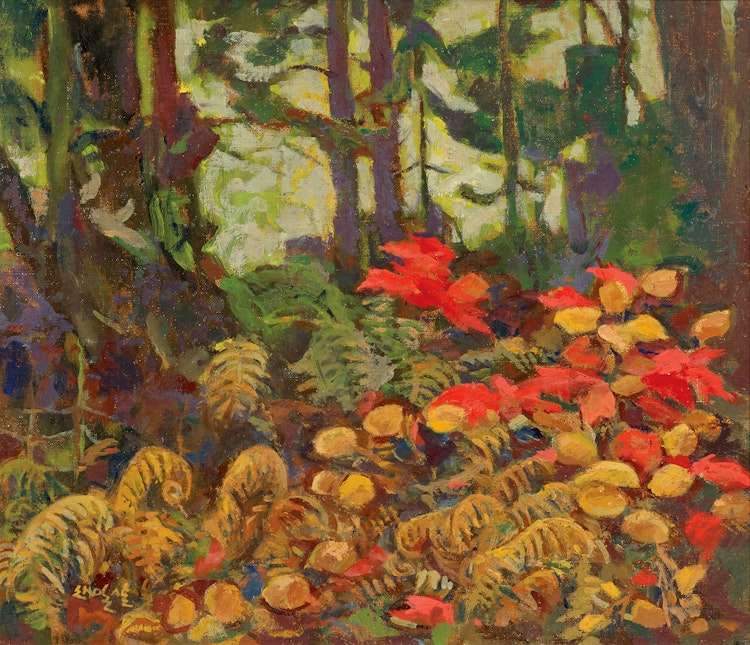Autumn Tangle by Edwin Headley Holgate

Edwin Holgate
Autumn Tangle
oil on canvas
signed lower left
12.5 x 14.5 ins ( 31.8 x 36.8 cms )
Auction Estimate: $30,000.00 - $50,000.00
Price Realized $78,000.00
Sale date: December 6th 2023
Ash Prakash & Associates, Inc., Toronto
Walter Klinkhoff Gallery, Montreal as “Autumn Tangle, Laurentians”, circa 1948
Private Collection, Toronto
“Edwin Holgate”, The Montreal Museum of Fine Arts; travelling to the Glenbow Museum, Calgary; The McMichael Canadian
Art Collection, Kleinburg; National Gallery of Canada, Ottawa; Beaverbrook Art Gallery, Frederiction, 26 May 2005‒15 April 2007, no. 119
“Embracing Canada: Landscapes from Krieghoff to the Group of Seven”, Vancouver Art Gallery; travelling to the Glenbow Museum, Calgary; Art Gallery of Hamilton, 30 October 2015‒25 September 2016 as “Autumn Tangle”, circa 1940
Dennis Reid, “Edwin H. Holgate”, Ottawa, 1976, page 22
Brian Foss, Rosalind Pepall and Laura Brandon, “Edwin Holgate”, 2005, no. 119, reproduced page 161
Ian Thom, et al., “Embracing Canada: Landscapes from Krieghoff to the Group of Seven”, Vancouver/London, 2015, reproduced page 139
Holgate painted “Autumn Tangle, Laurentians” two years later, depicting his preferred subject of periods of rapid change of the Canadian landscape between seasons. Dennis Reid remarks on Holgate's artistic output following his move, which accurately describes the colourful and dense composition: “His small oil sketches of the late forties and fifties in particular are sure and deft, spontaneous in response, yet resolved, tight works of art. Usually close-in, intimate studies of forest interiors, they are rich in observed detail and exciting colour.” Reid describes the artist's Laurentian works as “among the most sensual of his works, they reveal across every inch of their surfaces the long hours of concentration that have brought to them the gentle glow of life.”
Share this item with your friends
Edwin Headley Holgate
(1892 - 1977) Group of Seven, Canadian Group of Painters, Beaver Hall Group, RCA
Edwin Holgate was born in Allandale, Ontario. Holgate began his art education at the Art Association of Montreal studying under William Brymner who was also A.Y. Jackson's teacher. In 1912 he went to Paris where he studied at the Académie de la Grande Chaumière under Claudio Castelucho and later under Lucien Simon and René Ménard. He was in Russia at the outbreak of the First World War. He returned to Canada where he enlisted and served with the 5th Canadian Division Artillery in France (1916-19). He married Mary Frances Rittenhouse in 1920 and returned to Paris where he continued his studies. There he attended the Colarossi under Adolph Milman, a Russian refugee.
He returned with his wife to Canada in 1922 and opened a studio. He taught wood engraving at the Ecole des Beaux Arts for six years. In Montreal he enjoyed the friendship of A.Y. Jackson, Clarence Gagnon, Mabel May, Lilas Newton, Randolph Hewton, and many of the younger artists who became known as the Beaver Hall Hill Group. Holgate was a good skier and he would take trips to various parts of Quebec to sketch during the winters, sometimes at Baie St. Paul where A.Y. Jackson, Clarence Gagnon, Mabel May and others would congregate.
In 1926 he accompanied A.Y. Jackson and Marius Barbeau to the Skeena River area in British Columbia. Barbeau had been investigating the condition of the Indian totem poles, many of which were restored by the C.N.R. engineer Mr. T.B. Campbell. Holgate and Jackson made a number of sketches of the poles and the Indian villages in the area. From his sketches, Holgate made several large canvases. One is in the collection of the National Gallery and entitled is “Totem Poles, Gitsegiuklas”.
Holgate became the eighth member of the Group of Seven in 1931 and remained a member of the Group until it disbanded in 1933. From it arose the Canadian Group of Painters of which he was a founding member. Paul Duval noted that Holgate and Varley were the only members of the Group who drew and painted nudes. Holgate was well known also for his portraits and did many striking character studies of inhabitants of Canadian bush country. The Art Gallery of Ontario and the National Gallery of Canada have his nude studies in their collections.
During the Second World War, Holgate served overseas as an official Canadian war artist with the R.C.A.F. and painted mainly portraits of flying officers. Holgate’s wood-engravings are exceptionally well done and interesting. He was a member of the Royal Canadian Academy (A.R.C.A. 1934 - R.C.A. 1935). His work has been exhibited in many group shows over the years. He is represented in many collections including the National Gallery of Canada, the Art Gallery of Ontario, the Art Gallery of Hamilton and the McMichael Collection.
Source: "A Dictionary of Canadian Artists, Volume II”, compiled by Colin S. MacDonald, Canadian Paperbacks Publishing Ltd, Ottawa, 1979

